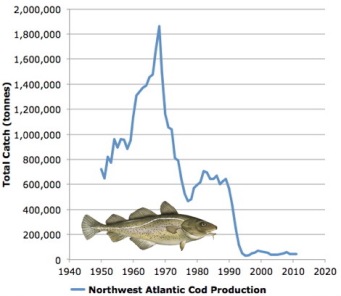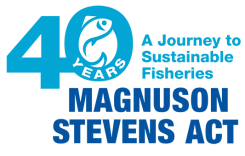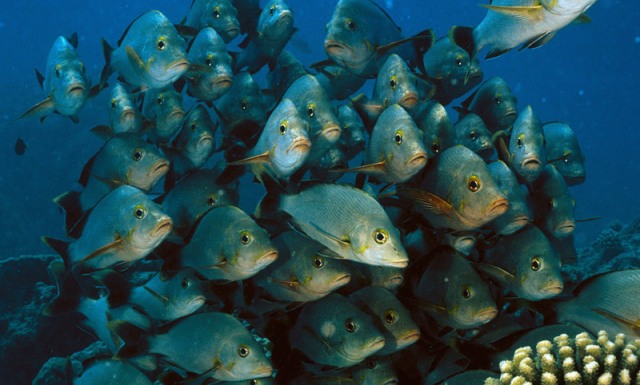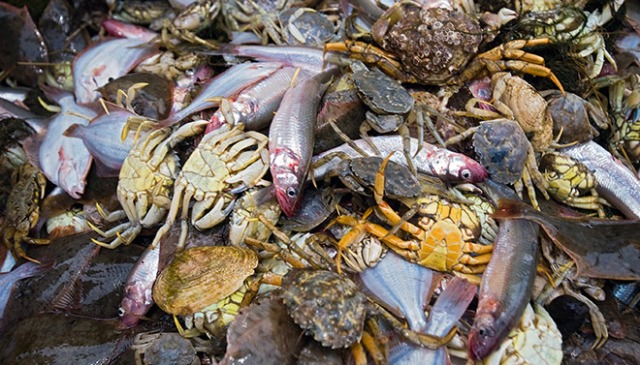THE 1990s are remembered as a time of relative prosperity. Wages were growing, colors were neon, and jackets were jean. But while most of us enjoyed grunge music and fanny packs, a serious environmental crisis was unfolding out at sea.

Fishery collapse occurs when a fish stock is reduced to less than 10% of its historic productivity. Collapsed fisheries are more vulnerable to environmental threats and exhibit slower population growth than healthy fish stocks. The New England cod fishery’s sudden collapse in the early 1990s followed severe overfishing in the preceding decades. Photo credit: UN FAO.
The ocean was running out of fish.
Following decades of plentiful fishing, the US commercial fleet sailed into rough seas in the late 1980s. The signs were sporadic at first. The size of individual fish began to shrink, and certain fish stocks began to disappear from inshore areas.
Then red snapper stocks crashed in the Gulf of Mexico in 1988. Summer flounder and bluefish followed in 1989 and 1990 respectively, dropping 60% from 1980 levels. The crisis morphed into disaster in 1992 when the New England ground fishery collapsed, decimating important species such as cod, haddock, and flounder as well as the regional economy.
By 1996, the US had declared 86 species overfished.
Fast forward twenty years, and only 29 species in US waters are classified as overfished. That’s a decrease of 66% from the peak of overfishing in the 1990s.
Stocks of bluefish and summer flounder have been successfully rebuilt, as have the previously decimated US stocks of lingcod, haddock, sea bass, rockfish, and sea scallops, to name a few. The health of US marine ecosystems has also improved as increasing fish stocks stabilize food webs and increase biodiversity.
The recovery of so many fish stocks hasn’t just benefited the ocean; it has also buoyed fishers and the fishing industry. Adjusting for inflation, the US commercial fishery saw dockside earnings increase by 54% as fish stocks around the country recovered.
So why did fish stocks recover? What turned an ecological and economic disaster into one of the greatest conservation success stories of all time?
The Magnuson-Stevens Act

The Magnuson-Stevens Act was originally passed as the Fishery Conservation and Management Act in 1976 to allow the US to expand control over its territorial waters. Only after fisheries began to collapse did the law’s focus shift to ecosystem based fisheries management. Photo credit: NOAA.
One year after President Clinton declared the New England ground fishery a federal disaster, congress met in Washington to amend and renew the 20-year-old Fishery Conservation and Management Act. The result was the Magnuson-Stevens Act, a major bipartisan commitment to end overfishing in US waters and promote fish stock recovery.
The goal of the Magnuson-Stevens Act was to create a framework for rebuilding overfished stocks in as short a time as possible. The timeframe for rebuilding a fish stock under the act is typically ten years or less.
To accomplish such a goal, scientists established fishery management plans for each overfished stock and instituted annual catch limits to control overfishing.
Annual catch limits are devised and adjusted based on data from scientific surveys. This form of adaptive management, where changes in scientific data prompt changes in catch limits, is a key reason for the law’s success.
By the end of 2015, 89% of fisheries with annual catch limits in place had halted overfishing.
In addition to setting catch limits, the law allows regulators to issue permits to fishing vessels, regulate allowable types of fishing gear, and establish zones or time periods that are off limits to fishing. The act also gives fishers a voice in the appropriation of annual catch limits, safeguarding fleet diversity and coastal livelihoods in the process.

The Magnuson-Stevens Act promotes ecosystem-based fisheries management by encouraging the conservation of critical marine habitats and populations of feeder fish that stocks depend on. Photo credit: David Doubilet, National Geographic.
While 64% of the fish stocks managed by the Magnuson-Stevens Act are now rebuilt or recovering, success hasn’t been universal. Certain regional fisheries, such as those in the Gulf of Mexico and New England, have struggled to control overfishing under existing regulations. The act also does a poor job of protecting highly migratory species, such as tuna, swordfish, and sharks, which move freely between different regulatory areas.
But the biggest hurdle to further progress has been a lack of scientific data for some fisheries. A sizeable minority of US fisheries still lack adequate data on stock levels and overfishing pressures, limiting the ability of regulators to institute catch limits or track stock recovery.
Despite these setbacks, the recovery of so many stocks has shown that the law works when funded and implemented as intended. By increasing fisher inclusion and data collection, the Magnuson-Stevens Act can ensure widespread the recovery of all US fisheries.
Tackling the Global Problem of Overfishing
Thanks to the regulatory success of the Magnuson-Stevens Act, only 16% of US fish stocks were deemed overfished in 2014, the lowest percentage since NMFS recordkeeping began.
Outside of US waters, a decidedly different narrative is unfolding.

Overfishing is a global problem. Photo credit: Michael Kirchner.
An estimated 63% of global fishing stocks are either overfished or in need of rebuilding, including economically and ecologically valuable species such as blue fin tuna and Atlantic salmon.
Confronting the problem of overfishing has proved challenging for countries across the globe. Lackluster fishery legislation in the EU has hampered the recovery of European fish stocks, with 44% of Northeast Atlantic stocks and upwards of 90% of Mediterranean fish stocks classified as overfished. The situation is grim in developing countries as well, with many fisheries in Eastern Africa and Southeast Asia languishing under intensive or destructive fishing practices.
Overfishing shouldn’t be viewed as an insurmountable problem or as an inevitable consequence of fishing. The recovery of US fish stocks, aided by effective fishery regulations, illustrates nature’s capacity to rebound if given the chance.
Global fisheries have the same capacity for recovery. A study released in March 2016 found that implementing best management practices across all fisheries would double global fish populations by 2050 and increase the proportion of fisheries considered biologically healthy from 47% today to 77% in as little as 10 years.
Without action, global fish stocks will be entirely depleted by 2050. As of 2010, 30% have already collapsed.
The international community should follow the regulatory example set by the Magnuson-Stevens Act. Nations need to implement science based catch limits and other best management practices to protect marine ecosystems. Without significant action, overfishing could truly cause the oceans to run out of fish.

Conservationists use the term “best management practices” to describe a series of strategies or actions that collectively promote conservation or sustainability. Designating marine protected areas, setting catch limits or quotas, tracking fish stocks in scientific surveys, and working to reduce bycatch all qualify as best management practices for fisheries. Photo credit: Getty Images.
What YOU can do
The Magnuson-Stevens Act has shown that fish stocks and marine ecosystems can rebound if given a chance to recover. While regulations are crucial for fishery longevity, fishery sustainability also depends upon the choices made by each and every consumer. Whether you are buying fish at the market or ordering seafood at a restaurant, your choices matter.
With a little help, consumers can wield their power to support best management practices and encourage the growth of sustainable fisheries. Pay attention to these labels while you shop to select sustainable seafood and encourage the recovery of our oceans:
1. Country of Origin – Retailers in the United States are required to package seafood with a country of origin label to give consumers a clear indication where each fish was caught or farmed. The United States is a global leader in sustainable seafood, followed by Norway, New Zealand, and Canada. The strong fishery regulations in these countries makes their seafood more likely to be sustainable.
2. Farmed vs. Wild – The rise of aquaculture, or fish farming, has taken significant pressure off of overfished wild stocks as the global demand for seafood continues to grow. Farmed fish, especially those raised in inland recirculating pools, tend to have less of an impact on natural marine ecosystems. Just like seafood sourced from nations with stringent regulations, farmed seafood tends to be more sustainable, although this is not always the case.

Look for this logo when you shop. Photo credit: Marine Stewardship Council.
3. Certified Sustainable Seafood – To find the most sustainable choices, look for products bearing the Marine Stewardship Council’s (MSC) logo. The MSC, a global non-profit, relies on fishery certification and ecolableing to raise consumer awareness about the importance of sustainable seafood. To gain certification, a fishery must have sustainable stock levels, demonstrate low environmental impact, and operate under effective management. Buying seafood with the MSC label takes the guesswork out of being an eco-conscious consumer.
You can also use the app Seafood Watch to find and learn about the most sustainable products on the market. The app labels different types of seafood as best choice, good alternative, or avoid to guide consumer choices. Fisheries are categorized by species, region, and harvest method in the app and are accompanied with compelling visuals and educational descriptions of fishery practices. The app is easy to use and allows shoppers to confirm the sustainability of their purchase in seconds.

Use the free app Seafood Watch to check if your favorite seafood is best choice, a good alternative, or a species to avoid consuming. Photo credit: Monterey Bay Aquarium.
LEARN MORE
- Why science is a required ingredient for sustainable seafood
- Interactive Timeline – US Fishery milestones under the Magnuson-Stevens Act
- How does the Magnuson-Stevens Act work?
- Global fish populations could double by 2050 under sustainable management


Thanks for this post! I had no idea that fish stocks were actually recovering in the U.S. nor had I heard about the Magnuson-Stevens Act. I will definitely try to keep using the Monterey Bay Aquarium’s Seafood Watch App though!
LikeLike
Yea, most of the time we hear about declining fisheries, which are common throughout the worlds oceans, so the US example of success is really a bright spot that countries around the world should strive to duplicate. And thanks for using Seafood Watch! Being an educated consumer is the best weapon you have against unsustainable fishing!
LikeLike
[…] continue to push this planet down a dangerous path towards unchecked climate change. Poaching, overfishing, and invasive species threaten ecosystems around the world. Habitat loss, the number one threat to […]
LikeLike
[…] where MPAs are unpractical or inappropriate, leaders should make use of regional ocean planning and scientific fisheries management to ensure the marine environment doesn’t get left […]
LikeLike
[…] How the world can stop overfishing – A case study of U.S. fishery success […]
LikeLike
[…] Overfishing in US waters is at a historic low, with only 16% of US stocks overfished compared to 63% globally, and that 39 US fisheries have recovered from overfishing since the 1990s. Ref: howtoconserve.org/2016/04/08/how-to-stop-overfishing/ […]
LikeLike
[…] How the world can stop overfishing – A case study of U.S. fishery success […]
LikeLike